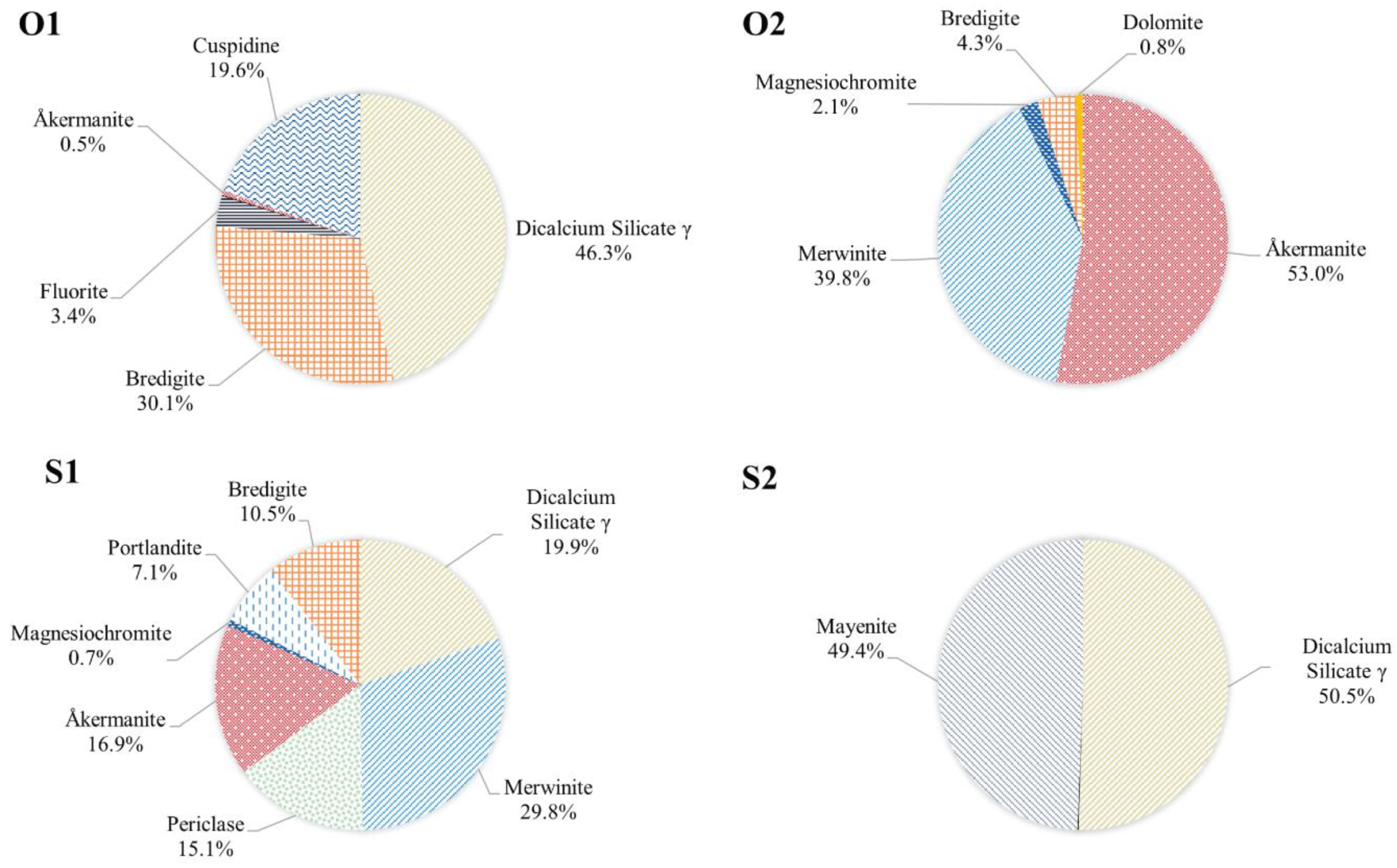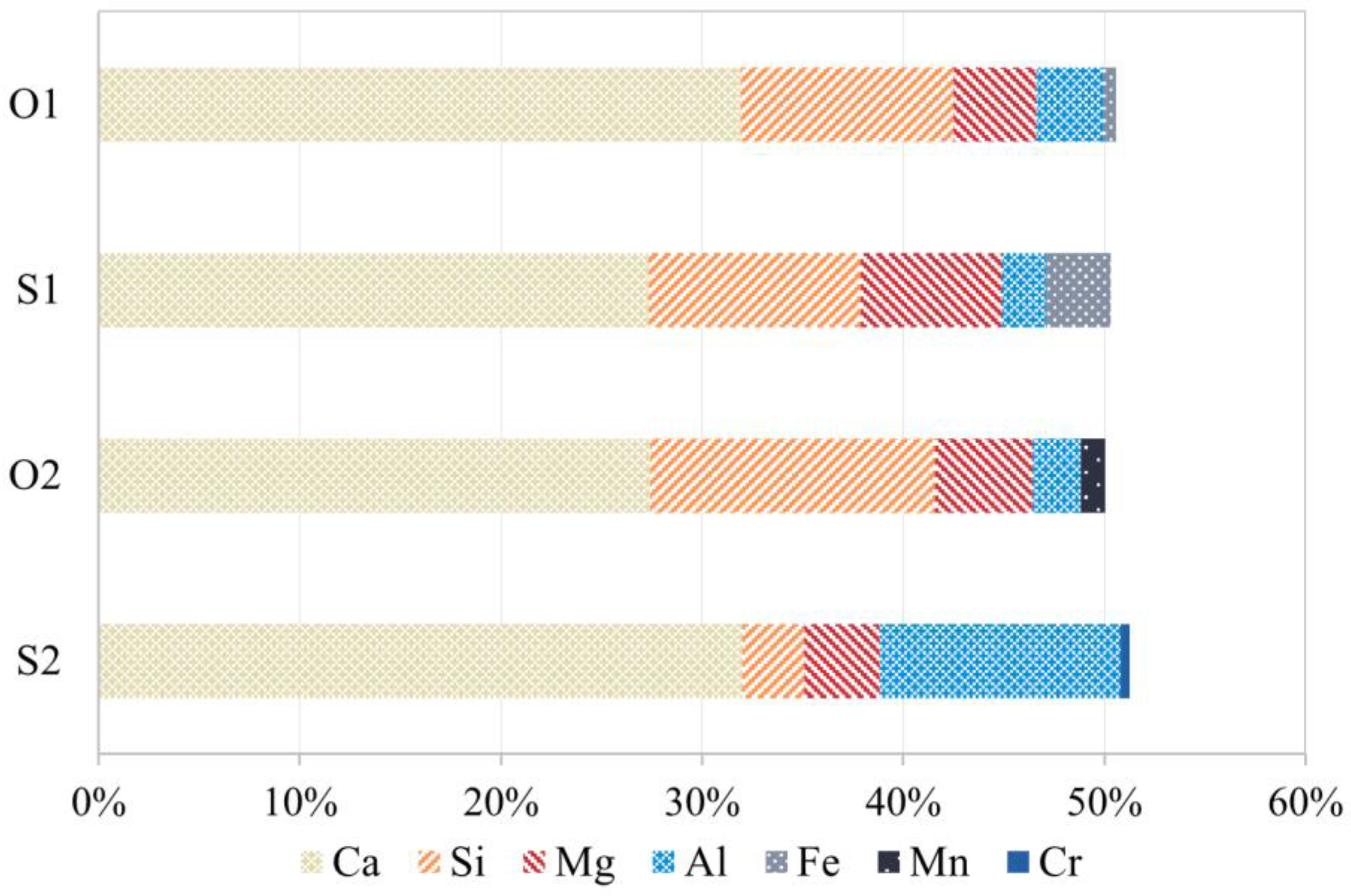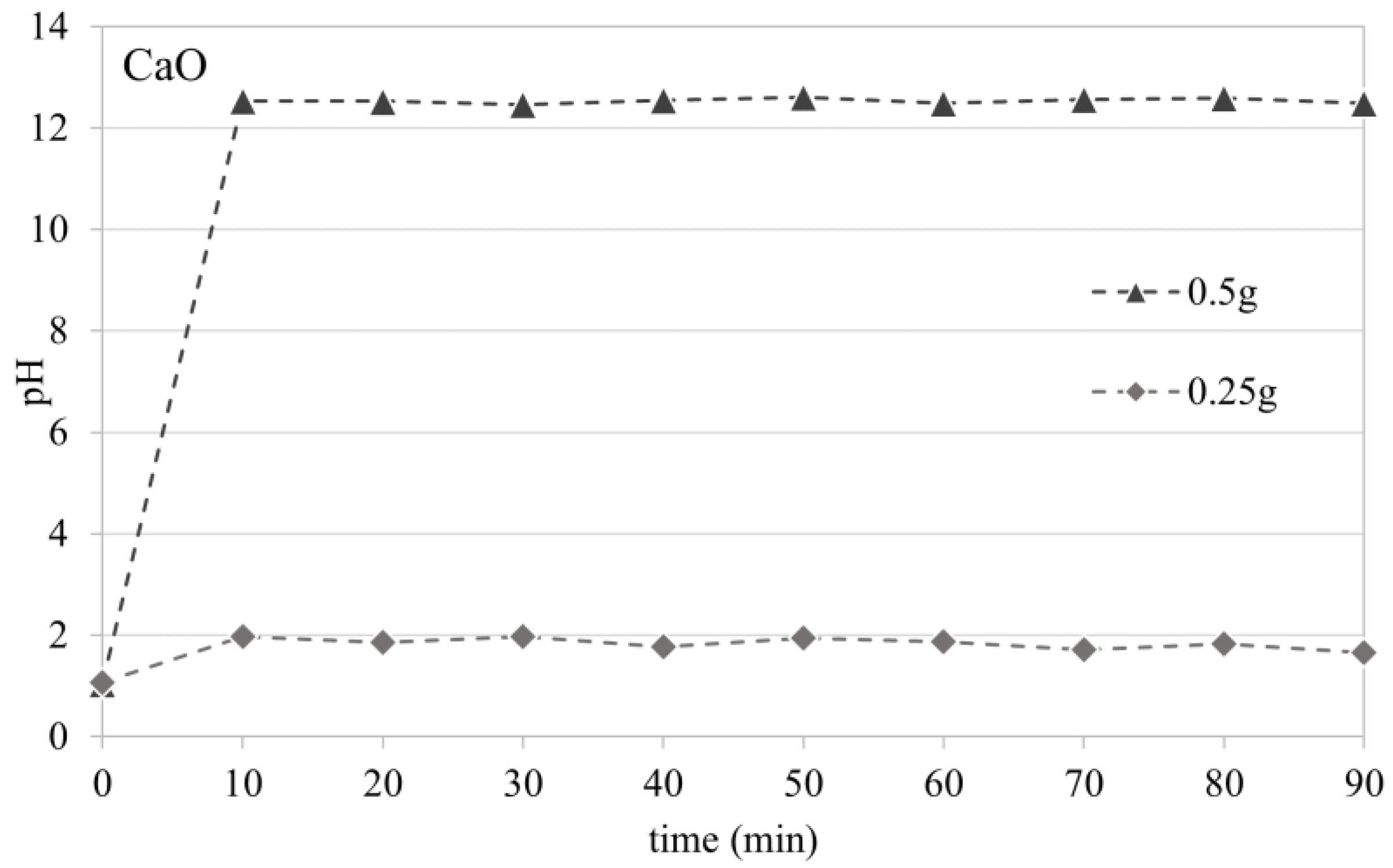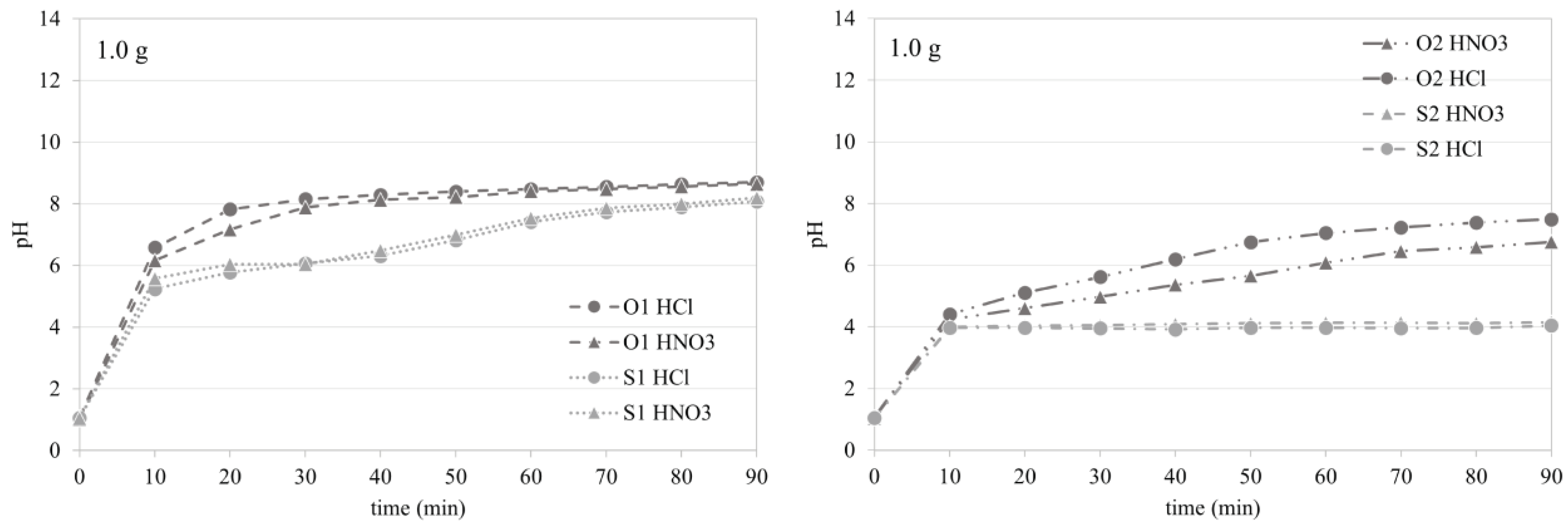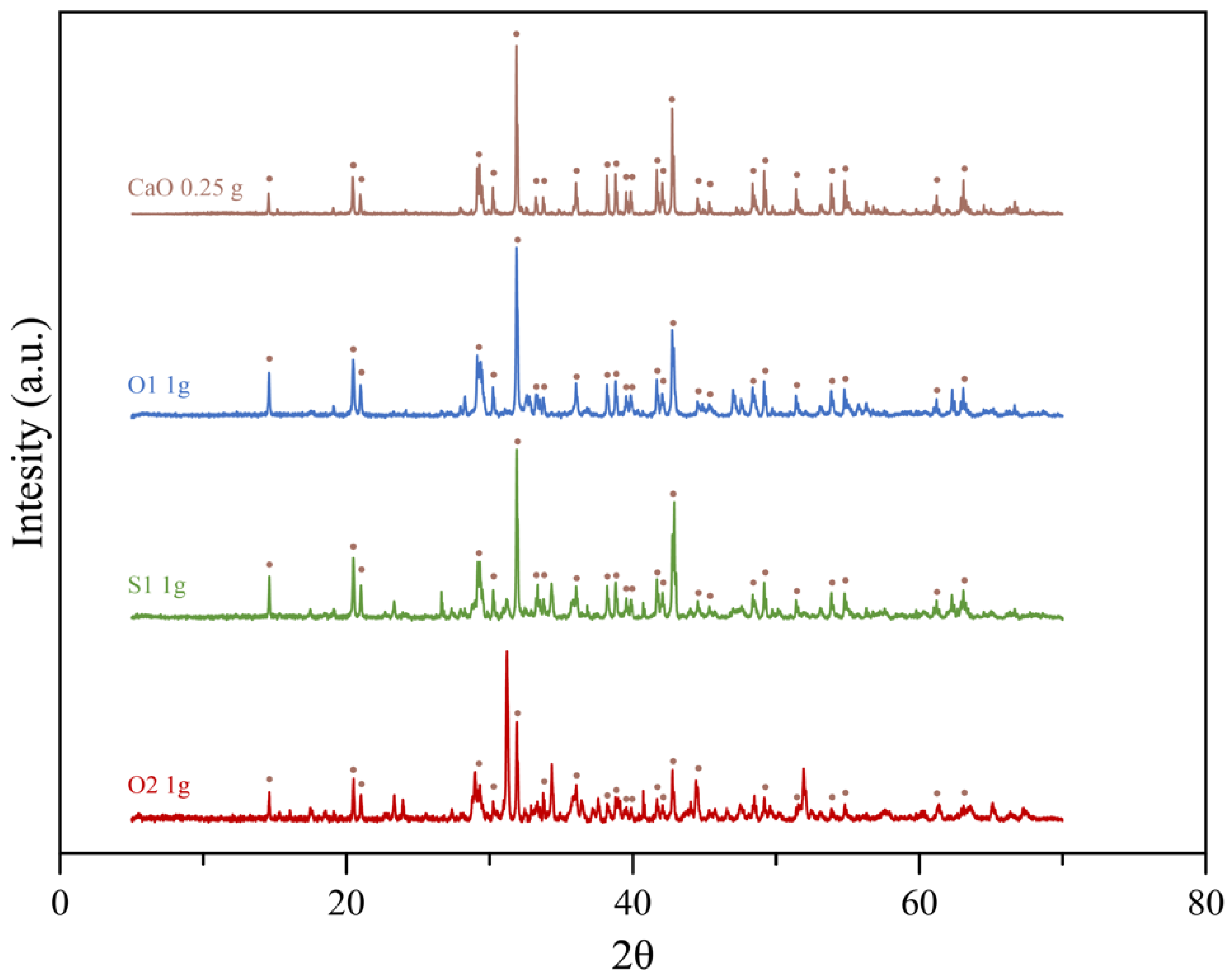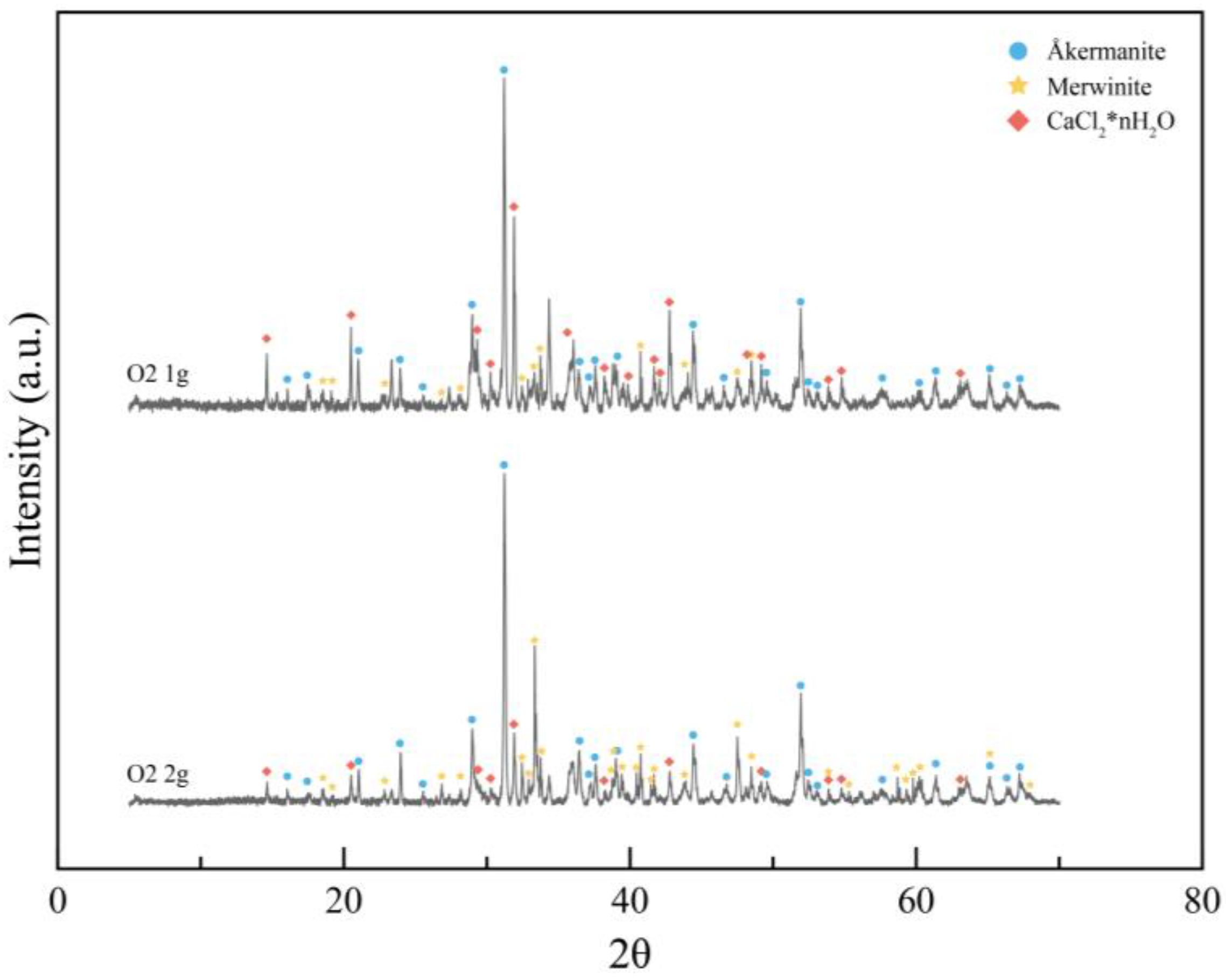1. Introduction
In 2019, 52 Mt of stainless-steel has been produced worldwide [
1], which generated roughly 15 to 17 Mt of slag [
2]. Compared to other kinds of by-products, such as Basic Oxygen Furnace (BOF) or Blast Furnace (BF) slags, which are well recycled in state-of-the-art applications, stainless-steel slags are mostly disposed in landfills. As an example, in Sweden only, stainless-steel slags are roughly 20% of the total amount of slags produced during the steelmaking processes. However, they constitute around 70% of the landfilled output [
3]. The high concentrations of leachable cancerogenic elements (such as Cr or Ni) in these slags, impedes their use in the common state-of-the-art applications, namely aggregates for road pavements or cement. Therefore, these kinds of slags are mostly disposed in landfills. Landfilling itself constitutes a problem too, because the same phenomenon generates risks of soil and water stream contamination, if not properly mended [
4,
5,
6,
7,
8]. In addition, the production of stainless-steel has been steadily growing since the year 2008 [
1], resulting in higher volumes of landfilled stainless-steel slags. Thus, it is imperative to find a solution for these kinds of materials, as landfills will progressively get filled. Furthermore, environmental restrictions are projected to tighten in the nearby future, resulting in an increasingly high economic liability for stainless steel producers.
One possible solution to the problem is to develop a novel application for these kinds of products. Several studies have already tested mineral by-products for the neutralization and treatment of industrial waste waters [
9,
10,
11,
12,
13,
14]. These waste streams can substitute the use of raw materials such as quicklime, which is the standard product used for water treatment, due to the high solubility and alkalinity of CaO. Steel and stainless-steel slags contain high percentages of CaO and MgO, which make them suitable replacements to quicklime. Previous studies [
15,
16] demonstrated that several stainless-steel slags could be employed for the neutralization and treatment of waste waters derived by the pickling process in steelmaking. The waste waters contained a dilution of different acids like HF, HCl, HNO
3 and H
2SO
4, which also presented high levels of dissolved metallic elements. Previous experiments demonstrated that as well as lime, the stainless-steel slags tested could rise the required pH values during the waste waters neutralization processes, while guaranteeing a comparable removal of metallic ions from the liquid phases [
15]. However, more systematic investigations are necessary to evaluate the efficiency of various stainless-steel slags in neutralizing the pH of acidic solutions. In fact, it is seen from previous studies [
10,
16] that the mineral composition of different slags affects the slags capacity of buffering acidic waters.
Mineral dissolution and element leaching are the phenomenon that dictates the reaction of slags and acidic waste waters. The dissolution of mineral phases in aqueous media is a complex phenomenon that varies vastly depending on the various parameters of the environment in which the solid materials are in contact with. The phenomenon is usually studied in terms of leaching behavior of slags, which is a detrimental effect when the material is used in standard applications as cement or asphalt mixtures. In the body of literature analyzed for this study, the pH value of the solution is considered one of the most important factors in the dissolution of the mineral phases. Experimentally, it was demonstrated that the more alkali in the solution, the lower the dissolution of the minerals [
17,
18]. This is also in compliance with more theoretical studies that used geochemical models to determine the leaching of mineral phases present in steel slags [
19]. In batch tests where the pH is not kept constant, the dissolution of the mineral phases is limited by the increase of the solution’s pH value. This phenomenon is well reported by De Windt et al. [
19]. In fact, the authors found that by reducing the L/S (liquid to solid) ratio by a factor of 10, it only increases the pH values from 11.2 to only 11.9. This means that at alkaline pH values, using 10 times the mass increases the pH value by less than a unit value. Similar results were obtained by Mombelli et al. [
20], which showed that only at L/S = 100 L/kg the slag is significantly dissolved. Contrary, for L/S = 10 L/kg the reactions between liquid and solid phases are only cortical, meaning that the dissolution of the mineral phase is stifled substantially by the alkalinity of the solution. Different dissolution rates at different pH levels are also reported by several other studies [
17,
18]. Although, when the pH value is continuously adjusted and kept to low values, the dissolution of minerals progresses to completion [
9,
10].
The pH value is not the only parameter that affects the dissolution of mineral phases. Several studies report different ion mobilities depending on the phases being dissolved. De Windt et al. [
19] shows how Ca and Si are the most leached elements from BOF slags, due to the high solubility of larnite. On the other hand, Mg and Al show very low mobilities since they are associated with Fe-bearing phases with very low solubilities. However, Cunha et al. [
9] report high solubility levels of Mg and Al, as well as a varying dissolution of Si depending on the material tested. Moreover, Mombelli et al. [
20] show an increased dissolution of Mg when the amount of dissolved Ca is low, while the dissolved Al content seems to increase the more Ca is being dissolved. Therefore, there seems to be no consensus regarding an independent leaching behavior of single elements. In fact, the aforementioned studies affirm that the dissolution of the mineral phases determines the solubilities of the elements leached in the solution [
9,
19,
20]. Overall, all the studies agree that Ca is the most mobile element, and most Ca-bearing minerals found in metallurgical slags are at least partially soluble in water.
In addition, different dissolved elements modify the pH value in different ways [
17,
18]. The theoretical chemical equilibria of the most common and abundant elements in steelmaking slags are listed in the following equations:
As is it possible to notice from Equations (1) and (2), Ca and Mg present the same chemistry: the oxides dissociate in a bivalent proton and a water molecule. This reaction raises the pH value of the solution by removing dissolved protons. However, the chemistry of Al and Si is more complex. Al oxides dissolves by consuming 6 protons forming 2 trivalent Al ions and 3 water molecules. In addition, Al is involved in two more reactions which both generate a proton as shown in Equations (4) and (5). Si also forms a proton when the hydrated form of its oxide dissociates in aqueous media. Pourbaix diagrams have been used in previous studies to determine the favored species as a function of the pH value [
17]. The diagrams are calculated using FactSage 6.1, according to a study made by Bale at al. [
21].By analyzing the graphs is it possible to notice that silic acid does not dissociate until very high levels of pH. Therefore, it does not contribute negatively to the increase of pH of the solution. On the contrary, Al
3+ is the favored species only at very low pH values. Afterwards the dominant species becomes Al(OH)
3 (s), which forms a proton as the result of its formation. Therefore, Al is expected to counteract the rise of the pH values caused by other elements such as Ca and Mg.
The present study aims at continuing the investigations on stainless-steel slags and their abilities to buffer the pH values of acidic waters, by improving the methodology developed in previous experiments [
15,
16]. The following experiments are designed to determine the effect of different mineral compositions on the pH buffering capacities of slags. The same kinetic conditions used in previous studies are maintained, as they also affect the final pH value obtained [
15,
16]. Furthermore, this study also tests the pH buffering capacities of slags in different acidic environments, as they have only been tested against specific kinds of acidic waste waters.
4. Discussion
The purpose of this research work is to progress the studies on the use of slag as a reactant for acidic waste waters treatment. This application is of interest especially in cases when the slag composition does not easily allow for a proper recycling in the state-of-the-art applications, namely as part of cement or asphalt mixtures. The same kinetic conditions of previous experiments [
15,
16] has been maintained, although the methodology has been improved in order to better study the effect of different mineral compositions on the neutralization performance. The same four slag samples used in the current research were first tested in a first feasibility study [
15]. This previous study did not focus on the particle sizes and mineral compositions of the slag samples. In addition, industrial waste waters with unknown compositions with pH values ranging between 1 to 2 were used. Moreover, the study aimed at measuring the amount of slag needed to reach pH 9 ± 0.2 by minute 30 by using a method that is highly influenced by the kinetic of the mineral dissolution. The obtained results showed that only slag samples O1 and S1 properly rose the pH to the desired values, and 40 to 50 g of slag per liter of industrial waste waters were needed. The following study by the same authors reduced and homogenized the particle size (≤63 μm) of the slag samples and replicated the same experimental methodology [
16]. Contrary to previous findings, in that study even slag O2 (EAF slag) reached the desired pH value, but not slag S2 (AOD slag). The study found that the O1 and S1 slag (landfill slags) samples were the best performing ones, utilizing approximately 20–25 g/L to reach a pH value of 9 in 30 min, whereas slag O2 needed roughly 40 g/L to reach the same target. Thus, the quantity of slag needed was halved due to a decrease in particle size. It should be noted that no possible connections between the pH levels obtained and the mineral composition could be drawn, as the latter was still not assessed.
The purpose of the given study is to analyze the differences in mineral compositions between the slag samples and to identify suitable slags for the neutralization of various acidic solutions. To do so, acidic solutions of known composition and controlled pH levels were preferred to industrial acidic waste waters used in previous experiments. Also, the slag particle size distribution was further reduced to diameters between 25 and 50 μm. Moreover, rather than aiming at the same pH levels between trials, the same weight values of acidic solutions and slag samples were used in the experimental trials, as it was deemed to be more controllable parameters. Therefore, a reliable comparison between pH levels obtained in this and previous study [
15,
16] was not possible to obtain. Nonetheless, although the current study did not aim at obtaining a pH value of 9.0 ± 0.2 at minute 30, in the trials in the present research performed with 2 g additions (20 g/L) of slag O1 and S1 the pH levels reached were 9.3 and 9.2 at the 30th minute, respectively. When 2 g of slag O2 were added, the pH value was 7.8 at minute 30. These results seem to be in line with the ones found in a previous study [
16], where around 20–25 g/L of slag samples O1 and S1 were needed to reach the desired pH values. Also, this is an additional confirmation that slag O2 performs worse than the other studied samples, due to its mineral composition. Regarding the slag sample S2, no quantitative comparison with previous experiments can be done [
15,
16], since successful neutralizations were never performed with such material before.
Given the complexity of the system involved, each slag samples should be evaluated separately analyzing its initial composition, the XRD patterns of the residues extracted after the neutralization trials, and the final pH levels obtained.
4.1. Dissolution of Slag O1
Slag O1 (landfill slag) is the best performing slag sample among the ones tested. When 0.5 g and 1 g are added, the highest final pH values are reached (4.4 and 8.7, respectively). Also, the pH rising rate is the highest among the studied slags (
Figure 4). When 2 g additions of slag are used it ties with the results using slag S1 both in terms of the rate of pH increase (
Figure 4) and its final values (9.6 and 9.5, respectively). Slag O1 contains the highest amount of Ca (31.9%) and Mg (4.1%) combined, which are the elements considered responsible for increasing the alkalinity of the acidic solutions. The slag is formed mostly by Dicalcium silicate γ (2CaO·SiO
2-γ, 46.3% of the total sample composition), bredigite (30.1%) and cuspidine (19.6%). The results of the XRD analysis of the residues, obtained by the neutralization trials performed using a 1 g addition of slag O1, show that all major peaks are attributed to CaCl
2·nH
2O, as shown in
Figure 9. The absence of intensity peaks corresponding to the original minerals, suggesting that the original mineral structure is completely disrupted by the end of the trial. Dicalcium silicate γ is a very common phase in metallurgical slags and has been proven to be highly soluble in water [
17,
20]. High dissolutions rates of cuspidine, especially for acidic pH values, have been observed by He and Suito [
26]. No information about the dissolution behavior of bredigite is available in the literature, but the results obtained suggest that the mineral is completely dissolved during the trials. In addition, previous experiments made by Cunha et al. [
9], where H
2SO
4 was used to dissolve several oxidic products, showed that the residues were formed by CaSO
4 as the main constituent, precipitated in several hydrated forms.
4.2. Dissolution of Slag O2
Slag O2 (EAF slag) is the third best performing slag based on the final pH levels obtained per unit of weight, despite the fact that it has the lowest total of Ca (27.4%) and Mg (4.8%) contents. When 1 g is used, the slag barely surpasses neutral pH values. Furthermore, when a 2 g addition is used, the final pH values are comparable with the pH values obtained using 1 g additions of slags S1 and O1. In fact, the final pH values reached with 1 g additions of slags O1 and S1 are 8.7 and 8.1 respectively. When a 2 g addition of slag O2 is added, a final pH value of 8.3 is obtained. Contrary to the composition obtained by using slags O1 and S1, CaCl
2·nH
2O is not the most abundant phase present in residues obtained when using slag O2. In fact, as shown in
Figure 9, the peaks associated with CaCl
2·nH
2O only partially describe the XRD pattern of the residues obtained in the neutralization trial. Also, according to
Figure 8 the abundance of the phase decreases in the 2 g trials in favor of the other phases. This is a common observation for slags S1 and O1 because the amount of Cl
2+ ions dissolved is the same in both trials, as the concentration of the acidic solution is the same. Thus, when the evaporation of the liquid phase occurs, the same amount of CaCl
2·nH
2O is formed when 1 g and 2 g additions are used. By using 1 g more gram of slag, the CaCl
2·nH
2O ratio diminishes. At the same time, the ratio of the other phases increases, and they become more visible in the XRD spectrum. In the trials performed with slag O2 it is particularly interesting to notice this phenomenon, because it provides information about what minerals are present when only a partial dissolution takes place. By comparing the results of the XRD analysis performed on the residues with the original slag composition and single mineral XRD patterns, almost all the peaks have been assigned to either merwinite, åkermanite or CaCl
2·nH
2O.
In
Figure 10, the XRD spectra of both residues obtained after the neutralization with slag O2 are analyzed. Both spectra present the same phases, but the ratio differs as beforementioned. By considering only the intensity of the peaks, and comparing the results to each other, åkermanite (4CaO·1.5MgO·0.5Al
2O
3·3.5SiO
2, cyan circle mark) is the most abundant phase in both cases. From roughly 47% of the total sample in the 1 g trial it rises to 54% in the 2 g trial. Merwinite (3CaO·MgO·2SiO
2, yellow star mark) increases from 9% to 27%. Conversely, the CaCl
2·nH
2O content (magenta diamond mark) drop from 28% to 10% of the total sample. Therefore, this is evidence that contrary to the results for the other minerals, such as the ones present in slag sample O1, merwinite and åkermanite do not fully dissolve in the current experimental conditions. Given the low content % of merwinite in the 1 g trial and its initial % in the slag sample (~40%), merwinite seems to dissolve more than åkermanite. This is in line with previous findings [
17], where a very different dissolution behaviors were found for the minerals tested and the pH levels of the solvent. Both merwinite and åkermanite show high dissolution levels and a fast dissolution rate at a pH value of 4. The dissolution rate at a pH value of 7 drops substantially, especially for åkermanite. However, it is still completely dissolved by the end of the trial. At a pH value of 10, the solubility drops significantly. Dicalcium silicate γ instead shows similar dissolution levels as merwinite and åkermanite only at a pH value of 4. Contrary to the other two, at a pH value of 7 the mineral dissolves with no visible difference compared to a pH value of 4. However, at a pH 10 the value of the dissolution level decreases. Although, it maintains a fast dissolution rate. In other studies, åkermanite is also shown to be less soluble, compared to other minerals like bredigite in a Tri-HCl solution of pH 7.4 [
27].
Nonetheless, the current study observes the dissolution behavior of minerals in a pH-variant environment, where the solubility of the species varies as well. Although, the results are compliant with previous findings made in environments using constant pH values. The lower dissolution kinetic of åkermanite compared to merwinite, especially around neutral values, means that more of the latter mineral is consumed when the pH level is crossing those values. This increases the pH value, until both minerals show very low solubilities. The faster kinetics of merwinite stifles the dissolution of åkermanite, by raising the pH value too fast for the second mineral to enable a complete dissolution.
4.3. Dissolution of Slag S1
Slag S1 (landfill slag) is the second-best performing material, despite the fact that it ranks third with respects to the total Ca (27.3%) and Mg (7.0%) contents. The sample is constituted of several of the minerals present in slags O1 and O2, as well as MgO and Ca(OH)
2. The pH levels obtained when using slag S1 are comparable to the ones obtained when using slags O1 and O2. The pH increase rate is slower compared to slag O1, and the final pH level obtained is between the results of slag O1 and slag O2 (
Figure 4). When 2 g of slag are used, the slag behaves identically to sample O1. When looking at the XRD spectrum of the residues obtained to those that used 1 g of slag. Specifically, the results are similar to those when using slag O1, where the most abundant phase present is CaCl
2·nH
2O. This means that most of the mineral phases that are present dissolve during the trial. However, since slag S1 is formed by six major phases, its behavior is hard to predict by only observing the composition. Dicalcium silicate γ and bredigite fully dissociates when using slag O1, whereas åkermanite only partially dissolves when using slag O2, due to its low dissolution kinetic. In fact, faint traces of åkermanite can be detected in the XRD spectrum of the residues obtained when using 1 g addition of slag S1. This confirm that the mineral does not fully dissolve during the trials. No traces of merwinite can be found in the XRD spectrum. Therefore, it is assumed that most of it dissolve during the trial. This is also in line with the behavior of slag O2, that shows very low levels of residual merwinite when the slag is not overdosed (1 g trial). Periclase, as lime, is also a very hydrophilic mineral. Therefore, its dissolution is considered to be complete.
4.4. Dissolution of Slag S2
Slag S2 has been constantly an outlier in all the experiments performed. Contrary to the results from all the other slag samples, 1 g of slag is not enough to neutralize the acid content of the solution. This is quite surprising, since the slags have high concentrations of Ca (32%) and Mg (~3.8%). Moreover, dicalcium silicate γ makes up roughly 50% of the slag composition. This mineral is also abundant in slag type O1 (46.3%) and a S1 (19.9%). In addition, just like dicalcium silicate γ, mayenite (12CaO·7Al
2O
3) has been reported to have good hydraulic properties [
28,
29] and high solubilities even at high pH values [
4]. Therefore, it is expected that the slag should show similar properties, if not better ones, than the previous slags. Instead, only when 2 g of slag are used, the material performs similarly to the other slag samples such as O1 and S1. The final pH value obtained when using a 2 g addition of slag S2 is approximately around 11, whereas additions of 2 g of the other slags could only rise the pH values between 8 and 9.6. Also, the final pH level is not reached gradually, but through a sharp increase around the end of the trial. This phenomenon happened also in the replication trial using the same quantity. Slag S2 is the only one containing mayenite, which is a mineral rich in Al. Al is the second most abundant element in slag sample S2, around 12% in weight, compared to a 2–3% content present in the other slags. As mentioned beforehand, Al is believed to counteract the rise of the pH value provided by elements such as Ca and Mg because its stable phases produce protons when being dissolved. This could explain why the pH values are so low compared to the ones obtained when the same weight of a different slag sample is used. The sharp rise in the pH value also is an interesting phenomenon worth exploring. According to the Purbaix diagram calculated in previous studies [
21], after pH value 9 is reached, Al(OH)
3 should further hydrate, which would generate a proton. In theory this should decrease the pH value, but the opposite happens. No explanation of this phenomenon could be found, but it is believed to be connected to the phase transition of the Al species.
The XRD patterns of the residues obtained with slag S2 are completely different from the ones obtained when using the other three slags. Contrary to slag O2, that partially retained some mineral phases from the original sample, no traces of mayenite or dicalcium silicate γ can be found. However, contrary to slags O1 and S1, there is no formation of CaCl
2·nH
2O. Therefore, SEM-EDS imaging was used to understand the composition of the residues. The analyses show an abundant presence of small particles with sizes < 1 μm (points 8,7,10,12 in
Figure 11). Given the very small size, these particles are considered to be precipitated compounds during the evaporation of the liquid phase. In fact, the slag samples have all been sieved to reach a size range of 25–50 μm. Thus, the presence of such a high number of very fine particles is otherwise unjustified. The fine particles contain Ca, O, Al and Cl as the main constituents. This explains why there is no trace of CaCl
2·nH
2O: the presence of dissolved Al bounds with Ca, Cl and O during the precipitation. Also, no traces of mayenite suggests that the mineral is the original mineral structure is completely dissolved and all the aluminum is dissolved in the acid.
5. Conclusions
This study aimed at analyzing the effect of composition of different stainless-steel slags, regarding their ability to increase the pH values of standard acidic solution. The same slag samples used in previous studies conducted by the same authors are also used in the current publication. Although, the methodology developed in the current study is different than the one used in previous experimental trials. The current study used a fixed amount of slag additions (0.5, 1 and 2 g), and track the different pH values obtained, whereas previous experiments focused on reaching the same pH value, with a ranging weight based on the different slags used. Furthermore, industrial acidic waste waters have been replaced with 0.1 M HCl/HNO3 solutions, and the quantity of solution to neutralize has been reduced from 1 L to 100 mL. Finally, the reacted slags and their leachates were extracted by drying the neutralized solutions. The residues were analyzed with XRD and SEM spectroscopies to determine their composition and infer the solubility of the original slag minerals.
The tested slags samples successfully rose the pH values to basic values of the 0.1 M monoprotic acid solutions (HCl or HNO3) prepared in laboratory trials. The results of this study further strengthen the case for the use of stainless-steel slags for waste waters treatment. However, compared to commonly used materials such CaO, all the slags tested dissolved with a slower rate, showed a lower solubility and reached lower final pH values. Also, slag requires roughly 3 times the weight of lime to reach similar pH values. Nonetheless, for processes characterized by high retention times and where a high basicity is not required, Al-rich slags can be successfully be employed.
When the weight and particle size of the slag sample, as well as the acidic environment are controlled, the composition of the slag is shown to heavily influence their performance as reactants. Although, the bulk chemical composition by itself is not able to precisely predict the performance of the material by itself. Similar percentages of the most abundant elements in the slag samples often lead to different results when analyzing the obtained pH values. In these cases, the mineralogical compositions of slags are more important parameters to control. Specifically, the different solubilities of the mineral phases in water media are the parameters controlling the choices of the slag for such use. Minerals with good hydraulic properties such as dicalcium silicate γ or bredigite are favored for such applications. At the same time, the same minerals are often problematic for other applications, because of their tendency to leach. On the contrary, minerals such as åkermanite and merwinite are less soluble, which impact the final pH levels obtained by unit of weight.
This study also found that high percentages of Al are detrimental to a successful neutralization as they generate hydroxides that dissociate in free protons, which decreases the pH value of the solution. As a result, the same amount of Al-rich slag (S2), that was successfully used for the other samples to rise the pH level, was not sufficient to neutralize the acidic solutions. However, when the quantity of slag is adjusted accordingly, the final pH value is higher (11.0) than the one obtained with the other slags (8.2–9.6). Therefore, when high basicity is needed, rather than weight efficiency, Al slags can be successfully employed for the neutralization of wastewaters.
